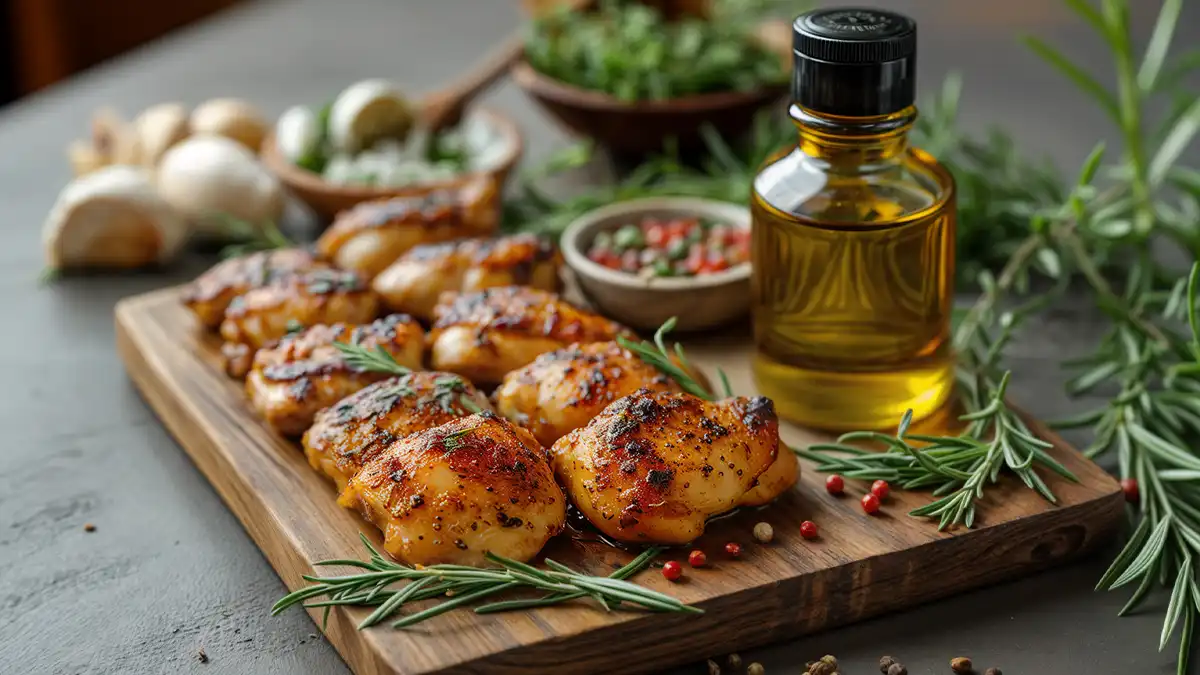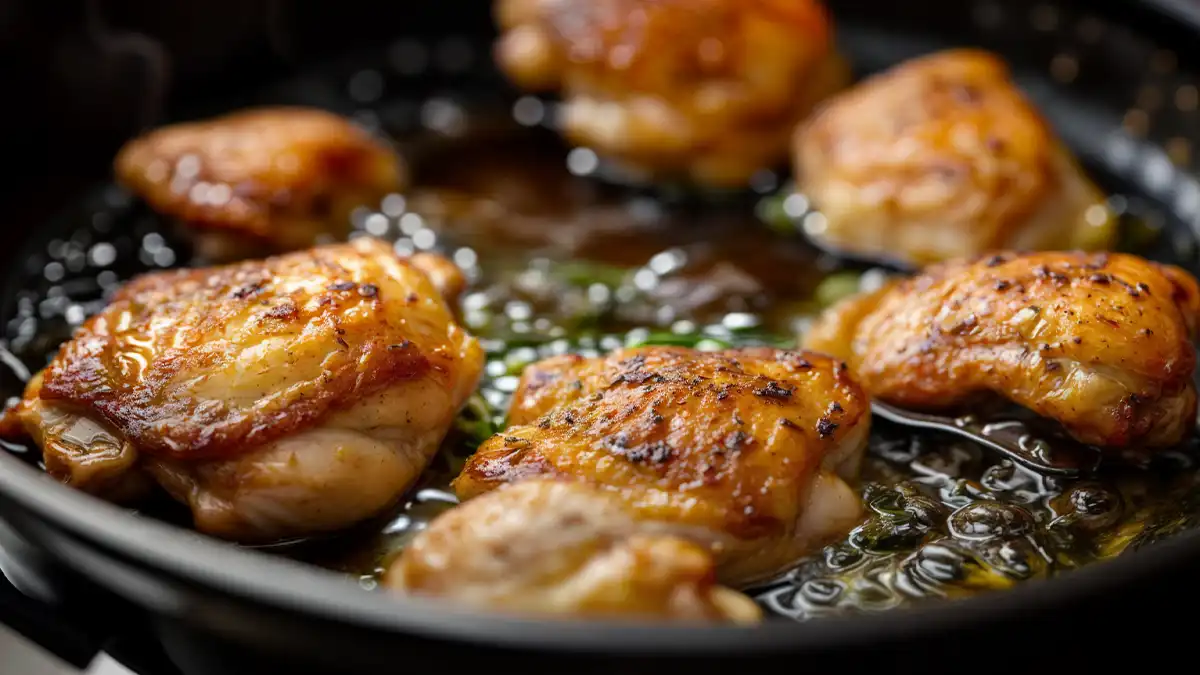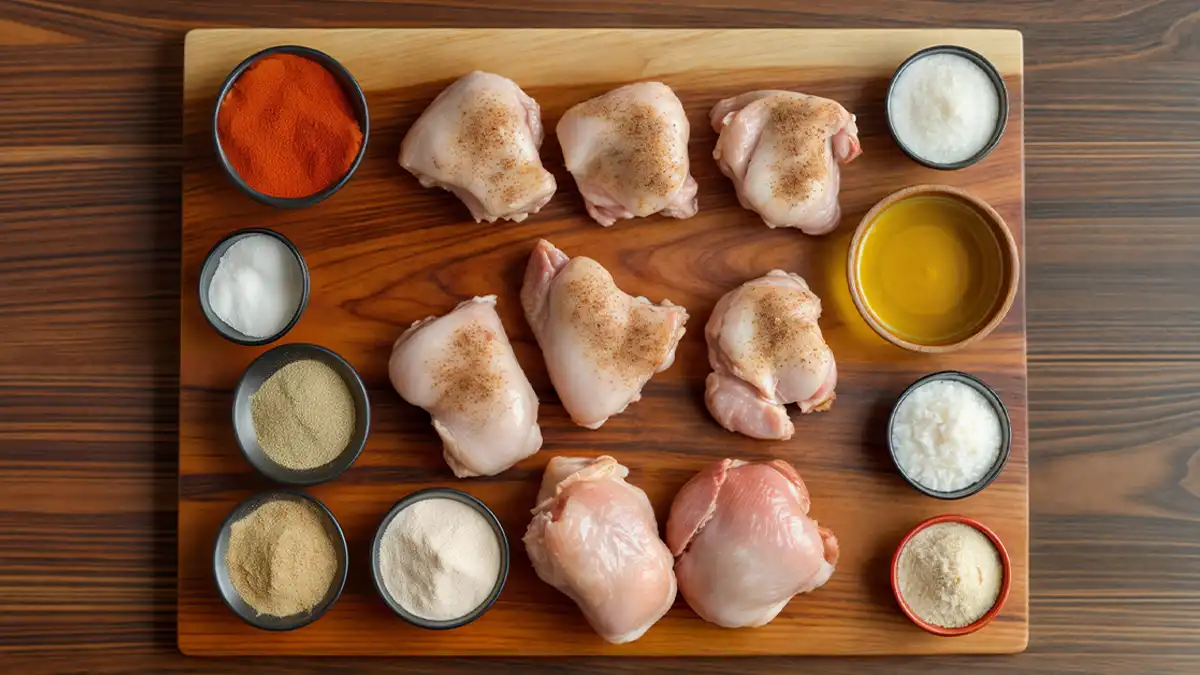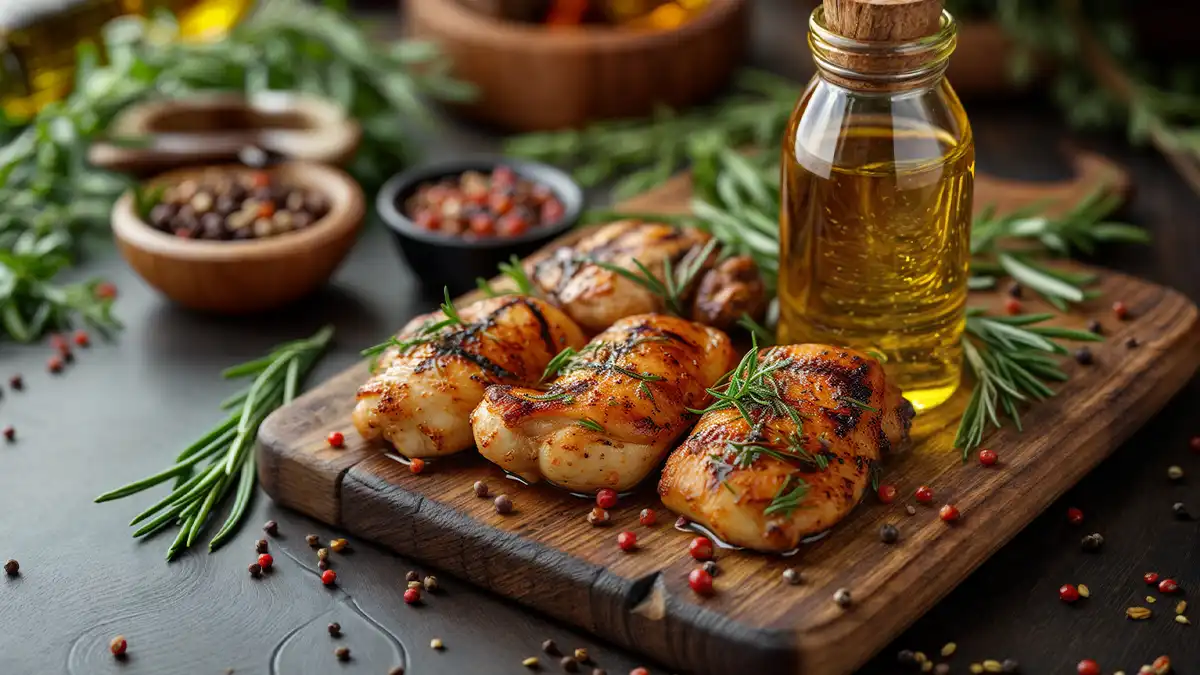Frying chicken in olive oil, a beloved cooking method across the globe, can be transformed into a healthier indulgence. Often chosen for its robust flavor and numerous health benefits, olive oil is not just a staple for dressings but also an excellent choice for frying. In this section, we delve into why olive oil stands out as a healthier alternative for cooking and how it enhances the taste of fried chicken without the guilt typically associated with deep-fried foods.
Table of Contents
| Section | Content |
|---|---|
| Introduction | Overview of using olive oil for frying, with benefits compared to other oils. |
| Understanding Olive Oil | Different types of olive oil suitable for frying, their characteristics, and smoke points. |
| The Frying Process | Techniques and tips for both shallow and deep frying chicken in olive oil. |
| Recipes and Cooking Techniques | A Mediterranean-inspired recipe and tips for seasoning and marinating chicken. |
| Nutritional Benefits | Health benefits of using olive oil, including its effects on cholesterol and heart health. |
| FAQ | Answers to common questions about frying chicken in olive oil, such as safety and oil reuse. |
| Conclusion | Summary of the benefits of using olive oil for frying and encouragement to try it in recipes. |
Why Choose Olive Oil for Frying?
Olive oil, especially the extra virgin variety, is rich in monounsaturated fats, which are good for your heart when used in moderation. Transitioning to olive oil from traditional frying mediums like vegetable oil or butter can decrease the intake of unhealthy saturated fats, making your fried chicken not only tastier but also more heart-friendly.
Comparing Olive Oil with Other Cooking Oils
| Oil Type | Monounsaturated Fat | Smoke Point | Flavor Profile |
|---|---|---|---|
| Olive Oil | High | 350 – 410°F | Rich, fruity |
| Canola Oil | Moderate | 400 – 450°F | Neutral |
| Vegetable Oil | Low | 400 – 450°F | Varies |
| Butter | Low | 250 – 300°F | Creamy, rich |
As shown in the table, olive oil not only offers a higher content of healthier fats but also maintains a decent smoke point suitable for frying. Its distinctive, fruity flavor can elevate the simple act of frying chicken into a culinary delight, enhancing the dish’s overall taste and aroma.
The Healthful Edge of Olive Oil
Using olive oil for frying chicken does more than just flavor enhancement; it contributes to your well-being. Rich in antioxidants and anti-inflammatory properties, olive oil can help reduce the risk of chronic diseases such as heart disease and diabetes. Moreover, unlike many other oils that degrade under high heat, olive oil maintains its nutritional profile, ensuring that you get the most out of your meal.
In conclusion, frying chicken in olive oil is not only a healthier choice but also a culinary technique that adds depth and richness to your dishes. As we explore further, keep in mind that the type of olive oil, the temperature, and the cooking method all play crucial roles in achieving the perfect fried chicken.
Understanding Olive Oil: The Best Choice for Frying Chicken
When it comes to frying chicken, selecting the right oil is crucial not only for flavor but also for health benefits and cooking performance. Olive oil, particularly known for its robust taste and health properties, stands out as a preferred choice for culinary enthusiasts. This section breaks down the types of olive oil and their benefits, ensuring you make the best decision for your fried chicken recipes.
Types of Olive Oil for Cooking
Olive oil comes in various grades, each suited for different cooking methods. Here’s a breakdown of the most common types used in kitchens:
- Extra Virgin Olive Oil (EVOO): The highest quality of olive oil with a rich, distinct flavor, perfect for dressings and gentle sautéing but also suitable for frying at moderate temperatures.
- Virgin Olive Oil: Slightly less refined than EVOO, with a good flavor profile and a higher smoke point, making it more adaptable for cooking at higher temperatures.
- Pure Olive Oil: Often labeled simply as “olive oil,” this type is a blend of refined and virgin oils, offering a higher smoke point with a milder flavor, ideal for general cooking needs, including frying.
Integrating olive oil into recipes like the Jamaican Beef Patty, which requires a bit of frying, can add a healthful twist to traditional recipes.
Decoding the Smoke Point of Olive Oil
The smoke point of oil is the temperature at which it begins to smoke and break down, affecting both the flavor and nutritional value. Here’s why the smoke point matters when you’re frying chicken:
- Maintaining Nutritional Integrity: Oils that smoke easily at lower temperatures can release harmful free radicals, diminishing their health benefits.
- Flavor Preservation: Overheated oil can impart a burnt taste to your food, which is particularly noticeable with a flavorful oil like olive oil.
| Olive Oil Type | Smoke Point |
|---|---|
| Extra Virgin | 350 – 410°F |
| Virgin | 390 – 440°F |
| Pure Olive Oil | 410 – 470°F |
Using the right type of olive oil for frying ensures that the chicken is not only cooked perfectly but also retains the subtle flavors that olive oil imparts. For instance, our recipe for Bishop Cake, while primarily a baked good, can benefit from understanding these nuances when incorporating olive oil into the baking process.
Choosing the Right Olive Oil for Your Kitchen
Selecting the right type of olive oil can enhance the cooking experience and improve your dishes’ health profile. Here are some tips to help you choose:
- Flavor Matching: Consider the flavor profile of the olive oil and how it complements your dish. For frying chicken, a more neutral flavor like that of pure olive oil might be preferable, especially if using strong spices.
- Heat Consideration: Evaluate the cooking method and temperature to select an olive oil with a suitable smoke point.
- Health Benefits: Opt for extra virgin olive oil if the health benefits of polyphenols and lower levels of processing are important to you.
By choosing the appropriate olive oil, you not only elevate the taste of your dishes but also incorporate a healthier cooking medium into your daily cuisine. With this knowledge, you’re well-equipped to select the best olive oil for frying chicken, ensuring delicious and health-conscious meals.
Mastering the Art of Frying Chicken in Olive Oil
Frying chicken in olive oil not only enhances the flavor but also infuses the dish with the health benefits of olive oil. This part of our guide focuses on the techniques for both shallow and deep frying chicken using olive oil, providing you with essential tips to get that perfect crispy texture every time.
Techniques for Shallow Frying Chicken
Shallow frying is a method where the chicken is cooked in a small amount of oil over relatively high heat. Here’s how you can master this technique with olive oil:
- Preparation: Start by selecting the right pan; a heavy skillet works best as it retains heat well. Add enough olive oil to cover the bottom of the pan, typically about half an inch.
- Heating the Oil: Heat the oil over medium heat. You can test if the oil is ready by dropping a small piece of bread or a pinch of flour into the oil. If it sizzles without burning quickly, it’s ready.
- Cooking the Chicken: Place the chicken pieces into the pan without overcrowding. Cook each side until golden brown and crispy, usually about 3-4 minutes per side depending on the thickness.
- Safety Tips: Keep a lid nearby to cover the pan in case of oil splatter. Also, use kitchen tongs to turn the chicken pieces to avoid splashes.
Integrate olive oil into diverse recipes like the flavorful Raspberry Chipotle Sauce to explore its versatility beyond frying.
Deep Frying with Olive Oil
Deep frying in olive oil allows for an even crispier and more flavorful chicken due to the complete immersion of the pieces in oil. Follow these steps to ensure perfect deep-fried chicken:
- Choosing the Right Container: Use a deep fryer or a large, deep pot to avoid spills and manage the oil temperature effectively.
- Oil Temperature: The oil should be heated to around 350°F. Use a cooking thermometer to check the temperature.
- Frying: Once the oil reaches the correct temperature, carefully lower the chicken pieces into the oil using a slotted spoon or fryer basket. Do not overcrowd the pot. Fry until the chicken is golden brown and cooked through, usually about 7-10 minutes.
- Post-Cooking Care: Remove the chicken and let it drain on paper towels or a cooling rack over a baking sheet to remove excess oil.
Explore the use of olive oil in different cuisines by incorporating it into recipes like our Boursin Cheese Pasta, where olive oil subtly enhances the creamy texture.
Maintaining Quality and Flavor When Frying
To ensure the best results when frying with olive oil, consider these additional tips:
- Reuse of Olive Oil: Olive oil can be reused if it’s strained after each use to remove food particles. Store the used oil in a cool, dark place and use within a few weeks.
- Flavor Preservation: Avoid overheating olive oil to maintain its flavor and nutritional properties. Keeping the temperature controlled is crucial.
For further insights and visual guidance on frying chicken in olive oil, watch this helpful tutorial video:
By following these tips and techniques, you can perfect the art of frying chicken using olive oil, making your meals not only delicious but also healthier. Whether you choose to shallow or deep fry, olive oil is an excellent choice for achieving that irresistible crunch and flavor.
Crafting Delightful Recipes with Olive Oil-Fried Chicken
Olive oil is not only a healthy cooking medium but also a versatile ingredient that can be used in various recipes to enhance flavor and texture. In this section, we’ll explore a Mediterranean-inspired recipe for fried chicken and share tips for marinating and seasoning to elevate your culinary creations.
Mediterranean Olive Oil-Fried Chicken Recipe
Ingredients:
- 2 lbs chicken thighs, boneless and skinless
- 1 cup all-purpose flour
- 2 teaspoons salt
- 1 teaspoon black pepper
- 2 teaspoons paprika
- 1 teaspoon garlic powder
- Olive oil for frying
Directions:
- Preparation: In a large bowl, mix flour, salt, pepper, paprika, and garlic powder.
- Marinating the Chicken: Coat the chicken evenly with the flour mixture. Let it sit for at least 30 minutes to absorb the flavors.
- Frying: Heat olive oil in a large frying pan over medium heat. Fry the chicken pieces until golden brown and cooked through, about 5-6 minutes per side.
- Serving: Serve hot with a side of lemon wedges and a fresh salad.
This recipe is perfect for a weekend meal or a special family dinner. For an even richer flavor, consider adding a few herbs like rosemary or thyme to the flour mixture.
Enhancing Your Dishes with Seasoning and Marinades
Flavor Boosting with Marinades
Marinating your chicken can drastically improve the depth of flavor and tenderness of the meat. Here are a few tips for creating effective marinades:
- Olive Oil Base: Use olive oil as the base of your marinades to ensure the chicken remains moist and flavorful.
- Acidic Components: Incorporate elements like lemon juice or vinegar to help tenderize the chicken and add a bright flavor.
- Herbs and Spices: Experiment with different herbs and spices such as oregano, basil, and cumin for varied flavor profiles.
By marinating chicken in these rich mixtures, you can enhance the natural flavors before frying it in olive oil.
Creative Alternatives to Frying
While frying is a popular method, olive oil also excels in other cooking applications. For instance, baking chicken after a light sear in olive oil can produce a dish that’s flavorful yet lower in fat. Explore recipes like our Chicken Cutlets in Oven for inspiration on using olive oil in baked dishes.
Tips for Perfectly Seasoned Fried Chicken
Achieving perfectly seasoned fried chicken involves more than just the right spices. Here’s what you need to keep in mind:
- Even Coating: Ensure each piece of chicken is evenly coated with the seasoning to prevent bland spots.
- Seasoning Under the Skin: For skin-on pieces, season under the skin for deeper flavor penetration.
- Post-Cooking Seasoning: Sprinkle a little salt or a custom spice blend on the chicken immediately after frying for an extra flavor boost.
To further explore the nutritional benefits of using olive oil in your diet, check out the American Heart Association’s guide on olive oil’s heart benefits.
By integrating these tips and techniques into your cooking routine, you can elevate simple fried chicken into a gourmet dish that delights the palate while maintaining health consciousness. Olive oil not only adds a distinctive flavor but also enhances the nutritional profile of your meals, making it a superb choice for any cooking enthusiast.
Nutritional Benefits of Frying Chicken in Olive Oil
Frying chicken in olive oil is not only about savoring the delightful crisp and flavor but also about reaping significant health benefits. Olive oil is renowned for its heart-healthy fats and antioxidants, making it a superior choice compared to other frying oils. This section will explore the various health advantages of using olive oil for frying chicken.
Heart Health Advantages of Olive Oil
Olive oil is predominantly composed of monounsaturated fats, which are known to improve heart health by lowering bad cholesterol levels and increasing good cholesterol. Here’s a quick look at how olive oil can benefit your cardiovascular system:
- Reduces Heart Disease Risk: Studies have shown that the monounsaturated fats in olive oil can help reduce the risk of heart disease.
- Lowers Blood Pressure: Regular consumption of olive oil has been linked to lower blood pressure levels, another key factor in heart health.
Olive Oil’s Impact on Overall Wellbeing
Antioxidant Properties
Olive oil contains various antioxidants, which are crucial in protecting the body from damage caused by free radicals. These antioxidants can help reduce oxidative stress and inflammation, leading to better overall health.
Diabetes Prevention
Using olive oil instead of other fats in cooking can also have a positive effect on blood sugar levels. The healthy fats in olive oil help slow down digestion, which can prevent spikes in blood sugar and help manage diabetes.
Comparing Fats: Olive Oil vs. Other Cooking Oils
Here’s a simple table comparing the fat content and health implications of different cooking oils:
| Oil Type | Total Fat | Saturated Fat | Monounsaturated Fat | Polyunsaturated Fat |
|---|---|---|---|---|
| Olive Oil | 14g | 2g | 10g | 1.5g |
| Canola Oil | 14g | 1g | 8g | 4g |
| Butter | 14g | 7g | 3g | 0.5g |
| Vegetable Oil | 14g | 2.5g | 3g | 8g |
As evident from the table, olive oil has a higher amount of monounsaturated fats and lower saturated fats, which are beneficial for maintaining a healthy diet.
Tips for Incorporating Olive Oil into Your Diet
- Cooking and Frying: Replace butter and other oils with olive oil when frying or sautéing.
- Salad Dressings and Dips: Use olive oil as a base for dressings and dips instead of mayonnaise or other high-fat bases.
- Baking: Substitute olive oil for butter in baking recipes to reduce saturated fat intake.
Integrating olive oil into your daily cooking practices not only enhances the flavor of your dishes but also contributes significantly to your health, making it an all-around excellent choice for a balanced diet.
FAQ About Frying Chicken in Olive Oil
In this section, we’ll address some common questions related to frying chicken using olive oil, helping you understand its benefits and how it compares to other cooking oils.
Is It Okay to Fry Chicken in Olive Oil?
Yes, it’s perfectly fine to fry chicken in olive oil. Olive oil is a healthy choice due to its high content of monounsaturated fats, which remain stable at the temperatures required for frying chicken. Using olive oil can add a delightful flavor to your fried chicken while also making it a healthier option.
What’s the Difference Between Using Olive Oil and Other Oils for Frying?
The main difference lies in the type of fats present in the oils. Olive oil contains more monounsaturated fats, which are healthier for the heart compared to the saturated fats found in many other oils like palm or coconut oil. Additionally, olive oil has a unique flavor profile that can enhance the taste of your dishes, unlike neutral oils like canola or vegetable oil.
How Many Times Can You Reuse Olive Oil for Frying?
You can reuse olive oil for frying 2-3 times, provided it’s strained after each use to remove any food particles. However, it’s important to check the oil for any off smells or excessive cloudiness, as these are signs that the oil is no longer good for cooking.
Is It Safe to Fry With Olive Oil?
Frying with olive oil is safe as long as you keep the temperature below its smoke point, which is around 410°F for extra virgin olive oil. This ensures that the oil doesn’t break down and release harmful compounds. Using a thermometer can help monitor the oil temperature effectively.
Which Oil Is Best to Fry Chicken?
While many oils can be used for frying, olive oil is one of the best choices due to its health benefits and ability to enhance the flavor of food. Its high monounsaturated fat content makes it more stable and beneficial for heart health compared to oils with higher saturated fat content.
Is Frying Chicken in Olive Oil Bad for Cholesterol?
No, frying chicken in olive oil is not bad for cholesterol. In fact, olive oil can help lower bad cholesterol levels and increase good cholesterol, making it a heart-healthy option for frying foods. This is due to the high amount of monounsaturated fats in olive oil, which are known to improve heart health.
By understanding these key aspects, you can make more informed choices about cooking with olive oil and enjoy the numerous benefits it offers, especially when frying chicken.
Conclusion: Embracing Olive Oil for Healthier, Flavorful Fried Chicken
Frying chicken in olive oil not only enhances the taste of this beloved dish but also promotes healthier cooking practices. Throughout this article, we’ve emphasized that olive oil offers benefits beyond flavor enhancement—it’s a heart-healthy choice that can positively influence your overall well-being.
Key Takeaways:
- Health Benefits: Olive oil is rich in monounsaturated fats, which are better for heart health compared to the saturated fats found in many other cooking oils.
- Flavorful Cooking: Olive oil adds a distinctive, rich taste to fried chicken, making it a favorite for those who appreciate gourmet flavors in everyday meals.
- Versatile Cooking Uses: Beyond frying, olive oil is excellent for sautéing, baking, and making dressings, providing numerous opportunities to incorporate it into your diet.
Choosing olive oil for frying not only improves the healthiness of your meals but also enhances their culinary quality. Frying chicken with olive oil showcases how this oil can turn basic ingredients into tasty and nutritious dishes.
We recommend trying olive oil for your next chicken dish to enjoy its taste and health benefits. Whether you prioritize flavor, health, or both, olive oil is an excellent choice for a healthy lifestyle without sacrificing taste.





